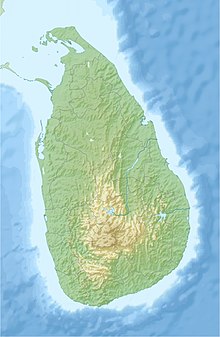SLAF Palaly
|
Jaffna Airport யாழ்ப்பாணம் விமான நிலையம் යාපනය ගුවන්තොටුපළ SLAF Palaly |
|||||||||||
|---|---|---|---|---|---|---|---|---|---|---|---|
 |
|||||||||||
| Summary | |||||||||||
| Airport type | Military/Public | ||||||||||
| Owner | Government of Sri Lanka | ||||||||||
| Operator | Sri Lanka Air Force | ||||||||||
| Serves | Jaffna | ||||||||||
| Location | Palaly, Sri Lanka | ||||||||||
| Commander | A. J. Amarasinghe | ||||||||||
| Elevation AMSL | 10 m / 33 ft | ||||||||||
| Coordinates | 09°47′32.40″N 80°04′12.30″E / 9.7923333°N 80.0700833°ECoordinates: 09°47′32.40″N 80°04′12.30″E / 9.7923333°N 80.0700833°E | ||||||||||
| Map | |||||||||||
| Runways | |||||||||||
|
|||||||||||
Jaffna Airport (Tamil: யாழ்ப்பாணம் விமான நிலையம், Sinhalese: යාපනය ගුවන්තොටුපළ) (IATA: JAF, ICAO: VCCJ) is an air force base and domestic airport in Palaly in northern Sri Lanka. Located approximately 16 km (9.9 mi) north of the city of Jaffna, the airport is also known as Palaly Airport and SLAF Palaly. Originally built by the Royal Air Force during World War II, it served as the country's second international airport before being taken over by the Sri Lanka Air Force.
During World War II the British Royal Air Force built an airfield in Palaly near Kankesanthurai in northern Ceylon. A number of RAF squadrons (160, 203, 292, 354) and air-sea rescue units were stationed at the airfield during and immediately after the war. The airfield was abandoned after the war and taken over by the Department of Civil Aviation.
The inaugural flight by Air Ceylon on 10 December 1947 was from Ratmalana Airport to Madras via Kankesanthurai. After independence the airport provided domestic flights to Colombo and international flights to south India. The growth of Tamil militancy put an end to civilian flights at the airport.
...
Wikipedia

